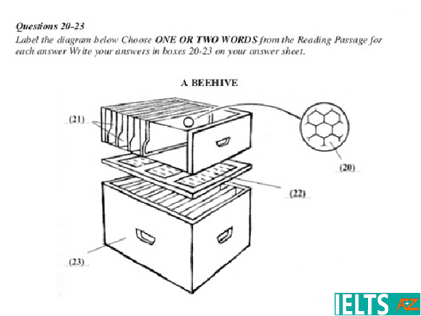Diagram Completion
In this page we will learn about, What is Diagram Completion?, Example of Diagram Completion, Strategies to answer the diagram completion questions, Tips for the diagram completion question, ELTS Diagram Completion Practice Exercise: Leaves' structure, and Answer and Explanations of Leaves' structure.
What is Diagram Completion?
In IELTS academic reading diagram completion, a paragraph and a diagram will be given, for which you have to label the parts referring to the passage. In this task, a diagram explaining a scientific or environmental process or the structure of a living or non-living thing is provided. Your task is to fill in specific parts of the diagram with text or words from the reading passage.
Example of Diagram Completion:

Strategies to answer the diagram completion questions:
- In the diagram, check the various components and their arrangements for proper understanding . If it is a Process Diagram, look at the arrows to understand the process.
- Also consider the words that are close to the blanks. These are mostly taken from the text or reworded with synonyms.
- Read the labels that are already provided, as these are helpful in finding the answer.
- You will find the answers in the description of the diagram.
- Before you answer a question, try to find a keyword present and highlight it.
- Complete the easy questions first, so that you may have more time to solve the difficult ones.
- The answers may not be followed in progressive order.
- Look at the parts to be labelled and find what type of information is required to fill in the blanks.
- Understand the link between the diagram and the label to fill in the blanks correctly.
Tips for the diagram completion question:
- Always underline new terms in the text; most of them will be used in the questions.
- The key words in the diagram may help you complete it.
This is what the diagram completion question may look like on the IELTS Reading test:
IELTS Diagram Completion Practice Exercise:
Leaves' structure
Plants play a very crucial role in our surroundings. Trees provide us with fresh air, shade in the summer, food, and other advantages without which we cannot even think of living.
A leaf is one of the principal organs of a tree. The leaves are the organs for photosynthesis—a process when carbon dioxide is converted into oxygen. The structures of leaves are enhanced for efficient photosynthesis.
Most leaves are broad and have a large surface area, which allows them to absorb more light. They are thin, which enables carbon dioxide to diffuse in and oxygen to diffuse out easily. The blade is the leaf's broad, flat part . Photosynthesis happens in the blade, which has many green food-producing cells.
If you look closer at leaves, you will notice the connectivity of thin threads. Those networks are called veins that support the structure of the leaf and transport substances to and from the cells in the leaf. The main vein of a leaf, running down the centre of the leaf, is known as the midrib.
The petiole is the area of some plants that links the stem and leaf of a plant. The petiole is the pipeline through which the products of photosynthesis are transported from individual leaves to the rest of a plant and through which necessary chemicals as well as nutrients from other parts of the plant are brought to individual leaves.
Label the diagram below.

1. __________________
2. __________________
3. __________________
4. __________________
Answer and Explanations of Leaves' structure:
1. An arrow near the number 1 indicates the little threads in the middle of the leaf. so, you'll see in the fourth paragraph:
"If you look closely at leaves, you will notice the connectivity of thin threads, which are referred to as veins."
So the answer is: veins or vein.
2. The second arrow indicates a large vein in the centre of the leaf.So, the fourth paragraphlast of the last sentence says:
"The main vein of a leaf that runs down the center of the leaf is known as the midrib."
So the answer is: midrib.
3.The main part of the leaf is captured by the bracket near number 3. The third paragraph shows us that:
"The blade is the broad, flat portion of the leaf".
So the answer is: blade.
4. The fourth part you must label the part of the leaf that links it to the plant’s stem. And once again, you scan the text for the words that are underlined and see this phrase in the last paragraph:
"The petiole which is the area of some plants that links the stem and leaf of a plant"
So the answer is: petiole.